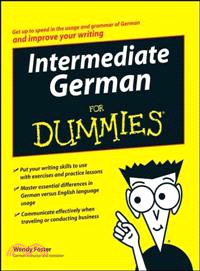| FindBook |
有 1 項符合
INTERMEDIATE GERMAN FOR DUMMIES的圖書 |
 |
INTERMEDIATE GERMAN FOR DUMMIES 作者:Foster,Wendy 出版社:John Wiley & Sons Inc 出版日期:2008-03-31 語言:英文 規格:平裝 / 322頁 / 2.5 x 20.3 x 25.4 cm / 普通級 |
| 圖書館借閱 |
| 國家圖書館 | 全國圖書書目資訊網 | 國立公共資訊圖書館 | 電子書服務平台 | MetaCat 跨館整合查詢 |
| 臺北市立圖書館 | 新北市立圖書館 | 基隆市公共圖書館 | 桃園市立圖書館 | 新竹縣公共圖書館 |
| 苗栗縣立圖書館 | 臺中市立圖書館 | 彰化縣公共圖書館 | 南投縣文化局 | 雲林縣公共圖書館 |
| 嘉義縣圖書館 | 臺南市立圖書館 | 高雄市立圖書館 | 屏東縣公共圖書館 | 宜蘭縣公共圖書館 |
| 花蓮縣文化局 | 臺東縣文化處 |
|
|
- 圖書簡介
Need to brush up on your German? Intermediate German For Dummies is your key to success in becoming confident in both written and spoken German. It gives you the straight talk and nitty-gritty detail that will see you successfully through any major or minor roadblocks to communicating in German.
This friendly, hands-on workbook is loaded with practical examples and useful exercises so you can practice how native speakers use the language. From vocabulary and numbers to juggling tenses, you’ll get a clear understanding of the nuances of German style and usage that will have you writing and speaking in no time. Plus, you’ll find multiple charts that provide conjugations for all types of German verbs. You’ll get up to speed with German grammar, master essential differences between German and English language usage, and be able to communicate effectively when traveling or conducting business. Discover how to:
Use fundamental German grammar, from nouns, adjectives, and adverbs to pronouns, prepositions, and conjunctions
Select and conjugate German verbs correctly
Understand the importance of grammatical gender in German
Avoid the most common writing mistakes
Use numbers and express dates and times
Name countries and nationalities in German
Expand your German vocabulary exponentially
Get comfortable with the subjunctive
Combine verbs with confidence and competence
If you’re heading to any German-speaking country, sharpen your German-language skills the fun and easy way with Intermediate German For Dummies. - 作者簡介
Wendy Foster was born in Connecticut and grew up in Scituate, Massachusetts. While studying in France, she traveled around Europe, and became curious about the German language and culture. After graduating with a teaching certificate and a degree in French, she decided to return to Europe to study German. Her love of the Alps inspired her to live in Munich, where she spent 30 years. During that time, she studied German, completed her MA in French at Middlebury College in Paris, and later learned Spanish in Spain. Her professional experience includes teaching Business English, German, French, and intercultural communication skills, as well as writing and translating. She recently returned to her New England roots, where she works from her home overlooking a spectacular salt marsh that constantly beckons her to go kayaking, walking, bird watching, and swimming.
- 目次
Introduction.
Part I: The Basic Building Blocks of German.
Chapter 1: Assembling the Basic Tools for German Sentences.
Chapter 2: Sorting Out Word Gender and Case.
Chapter 3: Laying the Foundations of German.
Chapter 4: Building Your Word Power.
Part II: Getting Started Now: Writing in the Present.
Chapter 5: Grasping the Present Tense.
Chapter 6: Are You Asking or Telling Me? Questions and Commands.
Chapter 7: Answering Intelligently with Yes, No, and Maybe.
Chapter 8: Describing Your Mood: Summing Up the Subjunctive.
Chapter 9: In the Mood: Combining Verbs with Modal Auxiliaries.
Chapter 10: Sorting Out Separable- and Inseparable- Prefix Verbs.
Part III: Fine Tuning Your Writing with Flair.
Chapter 11: Sounding More Like a Native with Verb Combinations.
Chapter 12: Adding Adjectives for Description.
Chapter 13: Comparing with Adjectives and Adverbs.
Chapter 14: Connecting with Conjunctions.
Chapter 15: Your Preposition Primer.
Part IV: Looking Back and Ahead: Writing in the Past and the Future.
Chapter 16: Conversing about the Past: Perfecting the Present Perfect.
Chapter 17: Narrating the (Simple) Past: Fact and Fiction.
Chapter 18: Looking to the Future (and Avoiding It).
Part V: The Part of Tens.
Chapter 19: Ten Tips for Optimizing Your German.
Chapter 20: Ten Pitfalls to Avoid in German.
Part VI: Appendixes.
Appendix A: Verb Charts.
Appendix B: Case Charts.
Appendix C: English-German Dictionary.
Appendix D: German-English Dictionary.
Index.
|











